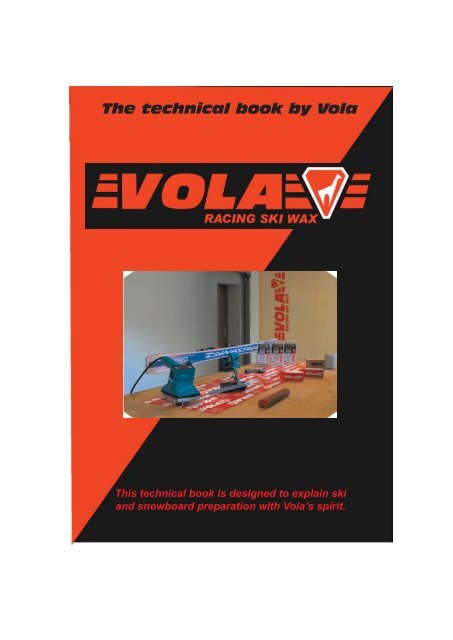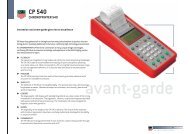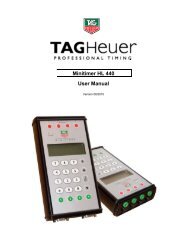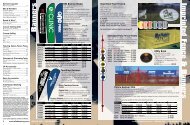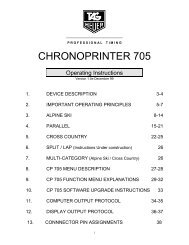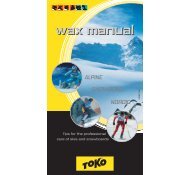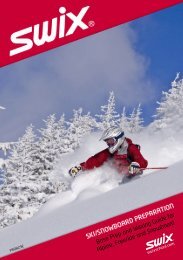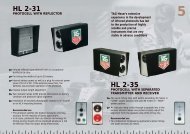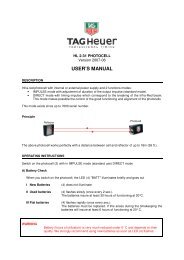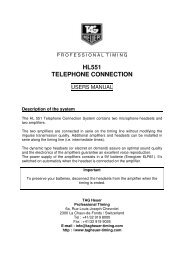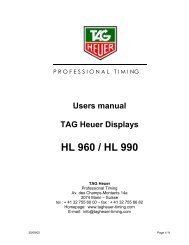Create successful ePaper yourself
Turn your PDF publications into a flip-book with our unique Google optimized e-Paper software.
The technical book by <strong>Vola</strong><br />
This technical book is designed to explain ski<br />
and snowboard preparation with <strong>Vola</strong>’s spirit.
<strong>Tech</strong>nical manual<br />
TO PUT THE BASE FLAT<br />
When receiving a new pair of skis it is very important to verify if the base of the ski is<br />
indeed fl at. To accomplish this we use a planimetre (ref 012005).<br />
Preparing the base of the ski is very important because it directly effects the skis<br />
behavior as a result of its contact with the snow.<br />
Ckecking of the flatness with the planimeter (ref 012005)<br />
Why work on the base ? Three important reasons exist.<br />
1/<br />
2/<br />
Flat Base = no problem<br />
If the base is convex = the ski will not track in a straight line and becomes<br />
unstable. In this situation the base needs to be scraped. Using a metal scraper (012003)<br />
or a planimeter (012005) you can remove material from the base bringing it back to its<br />
desired condition. Follow this process by using a brass brush (012009).<br />
3/<br />
If the base is concave = the ski will become harder to turn. The edges must be<br />
fi led down using a double cutting fi le (011035) or a black diamond stone (011040).<br />
Race skis typically use an angle of a few degrees on the base side of the edges. This<br />
will allow the ski to release properly and facilitate a proper turn shape. Typically this can<br />
be accomplished with a .5 degree base angle for slalom, 1 degree for giant slalam and<br />
1.5-2 degree angle for super-G and downhill.<br />
VOLA <strong>Racing</strong><br />
37, avenue de Saint Martin, B.P. 52, 74190 Passy, France<br />
Phone : +33 (0)4 50 47 57 20 Fax : +33 (0)4 50 78 11 91<br />
Email : vola@vola.fr<br />
Web site : www.vola.fr<br />
Page 2
<strong>Tech</strong>nical manual<br />
When the base is concave we recommend using the Base Edge tool<br />
which that will fi le down the edge with great precision.<br />
Base Edge Tool<br />
Ref 011023 : 0,5°<br />
Ref 011024 : 1°<br />
Ref 011025 : 1,5°<br />
THE SIDE<br />
On new skis (or snowboards) the fi rst step is passing the ABS tool over the edges .<br />
This plastic or metal band is designed to strengthen the edges.<br />
Do not over use the ABS tool at any one time it will make the edges become fragile.<br />
For best results use the ABS tool with care several times throughout the season.<br />
Edge<br />
Ege tool PRO.<br />
Ref 011051 (round blade)<br />
Angle of<br />
the file<br />
ABS<br />
VOLA <strong>Racing</strong><br />
37, avenue de Saint Martin, B.P. 52, 74190 Passy, France<br />
Phone : +33 (0)4 50 47 57 20 Fax : +33 (0)4 50 78 11 91<br />
Email : vola@vola.fr<br />
Web site : www.vola.fr<br />
Page 3
<strong>Tech</strong>nical manual<br />
THE TUNING<br />
The majority of ski preparation or tuning is accomplished using a 200mm fi le (011038)<br />
cutting the entire length of the edge.<br />
When using a fi le to cut the edge you may work effectively from the tip to tail or tail to tip,<br />
however it is very imortant to apply the same pressure to the edge over the entire ski.<br />
Do not apply excessive pressure. We recommend using the Corner-Plier system it may<br />
be less convientant to use than the more complex sharpeners, however, applies superior<br />
results.<br />
On clean edges a 150mm fi le is suffi ent. The corner are available from 90 degrees to 85<br />
degrees.<br />
The greater the angle the sharper and more aggressive the ski will preform, but may<br />
result in the ski becoming very reactive to ski pressure.<br />
We reccomend not to tuning at 90 degrees for the following reasons : the angle on the<br />
side must be at least the same as on the base (to obtain 90 degrees).<br />
Currently skis are manufactured with specifi c angles, therefore we recomend detirmining<br />
these angles before tuning.<br />
VOLA <strong>Racing</strong><br />
37, avenue de Saint Martin, B.P. 52, 74190 Passy, France<br />
Phone : +33 (0)4 50 47 57 20 Fax : +33 (0)4 50 78 11 91<br />
Email : vola@vola.fr<br />
Web site : www.vola.fr<br />
Page 4
<strong>Tech</strong>nical manual<br />
THE FINISH<br />
For best results it is important to use a stone for the best fi nish. This will polish the edge and<br />
remove any bur created by the fi le. We recommend using the Arkansas Hard (011049). The stone<br />
can be used with the corner guide, however, it is best used with hands. It is important to put water on<br />
the stone prior to use and to keep the stone wet throughout usage. The diamond stone is very useful<br />
as it accomplishes the same results as a smooth fi le and a stone.<br />
Red and blue stones are best for fi nishing, the black stone for<br />
more burred edges. The diamond stone is a tool that can be<br />
used in both the ski room as well as on the hill at a race. After<br />
using the stone, a robber block (gummy stone) can be used to<br />
clean the edge or to de-tune the edge in softer snow conditions.<br />
Once you have tuned the entire ski to the desired sharpness,<br />
we recommend de-tuning the tips and tails of the ski to allow<br />
the ski to better transition in and out of turns. In most<br />
conditions de-tuning is less and less critical as carving skis<br />
uses the entire length of the ski. Don’t forget to clean the<br />
plastic or metal tail strip located at the tail of the ski.<br />
VOLA Diamonded plates<br />
100: ref 011043<br />
400: ref 011044<br />
600: ref 011045<br />
1000: ref 011046<br />
THE BRUSHING<br />
It is important to brush the base of the ski while you are<br />
tuning with a brass brush to avoid the base getting dirty.<br />
Brushing must be done with an appropriate amount of<br />
pressure : enough to remove unwanted materials but not<br />
too much (do not cruch the bristles) that may cause<br />
damage to the base.<br />
012009<br />
Brass brush<br />
012006<br />
Nylon brush<br />
012010<br />
Horse hair brush<br />
012008<br />
Oval <strong>Racing</strong><br />
Nylon/Brass brush<br />
VOLA <strong>Racing</strong><br />
37, avenue de Saint Martin, B.P. 52, 74190 Passy, France<br />
Phone : +33 (0)4 50 47 57 20 Fax : +33 (0)4 50 78 11 91<br />
Email : vola@vola.fr<br />
Web site : www.vola.fr<br />
Page 5
<strong>Tech</strong>nical manual<br />
THE WAXING<br />
A ski base doesn’t glide directly on the snow but on water droplets created by the<br />
heat due to friction between the ski and the snow. A fl uoro was repels water at a<br />
greater rate than non-fl ouro wax thus the ski moves faster accross the snow.<br />
The <strong>Vola</strong> starters allow for strong acceleration at the start for maximum speeds.<br />
Do not leave the base unwaxed for any extended period of time. Also remove<br />
the wax from the edges of the ski.<br />
Before waxing, brush the base using a brass brush to clean the base. Apply some droplets<br />
of wax along the entire ski. Once the droplets are in place use the iron to spead the wax<br />
uniformly across the ski and then slowly continue this process for proper application.<br />
It is not nessesary to use too much wax because any excess will be scraped off once the<br />
iron has cooled.<br />
A proper amount provides a thin layer between the iron and the base to protect the base<br />
from the direct heat of the iron. Remove the wax on the edges with a plastic scraper.<br />
«Bravo» electronic wax iron<br />
Ref 012015<br />
It is very important not to over heat or burn the wax. Flouro waxes are especially sensitive<br />
as overheating will release the fl ourocarbons and make the wax less effective. Wax the<br />
skis in an open room with good ventilation where the tempeture is not too cold. The wax<br />
will need time to absorb into the base if the temperature is too warm it may take hours<br />
before scraping. It is also important to clear all other tools from the wax table otherwise<br />
there is potental to be dirtied by wax.<br />
VOLA <strong>Racing</strong><br />
37, avenue de Saint Martin, B.P. 52, 74190 Passy, France<br />
Phone : +33 (0)4 50 47 57 20 Fax : +33 (0)4 50 78 11 91<br />
Email : vola@vola.fr<br />
Web site : www.vola.fr<br />
Page 6
<strong>Tech</strong>nical manual<br />
Leave the ski until the wax has saturated into the base. The wax must be completely cooled<br />
before scraping (we recommend to wait at least 2 hours). Scrap the wax and then brush<br />
with a fi nishing horsehair brush (012010).<br />
On new skis, it is important to clean and and the base. We recommend waxing several<br />
times using parafi n R021 (229100) and to scrap while the wax is still warm, this will clean<br />
the base. Then wax 3 or 4 times with parafi n R 021 and then with a hard base wax such as<br />
(Green Slalom or Carving Base).<br />
Let it cool for several hours and scrap. This will saturate the base and make it harder and<br />
more resistant to base damage on hard and abrasive snow. Do these 4 waxing steps<br />
( 3 R 021, 1 Base) again 3 or 4 times.<br />
Parafin R021<br />
Ref 229100<br />
THE STRUCTURE<br />
Super Pro Plus vice<br />
Ref 014007<br />
Wax table with rack<br />
Ref 016011 (wax table) / 016012 (rack)<br />
The structure matters most when the ski is gliding. We observed that recently more and<br />
more ski manufacturers are supplying skis marked with an intermediate structure. Similair<br />
to waxes, snow conditions correspond with different structures. Liqueur brandy (fi ne or<br />
thin structures) work well in cold snow. In warmar/wetter snow conditions more agressive<br />
grinds are preferred. In the technical events more tilted grinds allow the skis to move freely<br />
and make for better turning performance. It is important to work in new grinds by skiing<br />
and waxing regularly (R021+Base) and brushing as often as possible. These actions will<br />
reduce the porosity of the polyethylene.<br />
With :<br />
Round structure<br />
Crossing structure<br />
VOLA <strong>Racing</strong><br />
37, avenue de Saint Martin, B.P. 52, 74190 Passy, France<br />
Phone : +33 (0)4 50 47 57 20 Fax : +33 (0)4 50 78 11 91<br />
Email : vola@vola.fr<br />
Web site : www.vola.fr<br />
Page 7
<strong>Tech</strong>nical manual<br />
VOLA waxes<br />
UNIVERSAL<br />
Universal waxes have a wide temperature range and is<br />
designed for everyday usage. The wax works best for air<br />
temperature from 8°C to 20°C.<br />
Ref 222000<br />
SPEED<br />
Speed waxes are for everyday use on speed skis for<br />
the following respective air temperatures.<br />
Blue:-25°C in 12°C Red:-14°C in 4°C<br />
Yellow:-6°C in +20°C<br />
The Speed waxes are used for training and to<br />
take of the skis.<br />
RACING / PRO<br />
The ranges of <strong>Racing</strong> and Pro waxes similarly<br />
correspond in three main colors the use depending<br />
on air tempature and snow conditions. The wax<br />
<strong>Racing</strong> is a wax for race of very good quality<br />
adapted for the regional and national races. It can<br />
also be apply for high-level races replacing the<br />
fl uoro waxes on very dry snows hygrometry.<br />
The wax Pro is the wax for races with fl uor to<br />
obtain perfect glide.<br />
Ref 221100 Blue<br />
221101 Red<br />
221102 Yellow<br />
Ref 223100 Blue<br />
223101 Red<br />
223102 Yellow<br />
VOLA <strong>Racing</strong><br />
37, avenue de Saint Martin, B.P. 52, 74190 Passy, France<br />
Phone : +33 (0)4 50 47 57 20 Fax : +33 (0)4 50 78 11 91<br />
Email : vola@vola.fr<br />
Web site : www.vola.fr<br />
Page 8
<strong>Tech</strong>nical manual<br />
LES FARTS LIQUIDES<br />
The liquid wax is very easy to use and can be applied very quickly.<br />
It is easy to apply the liquid wax using a cloth. Wait between fi ve<br />
and ten minutes once the wax has been applied to let the liquid dry.<br />
The liquid wax will also soak in deeper to the base of the ski.<br />
Before the application of the liquid wax it is important to maintain<br />
it at 20°C so that it remains very visscus allowing it to soak deeply<br />
into the ski.<br />
The use of nylon brush can help highlight the structures of the base<br />
before the application of the liquid.<br />
Nevertheless, we disadvised to use only the liquid waxes because it<br />
would dry the base. Always use a solid wax between two waxing<br />
with liquid waxes.<br />
Low Fluor<br />
Ref 224700 Blue<br />
224701 Red<br />
224702 Yellow<br />
High Fluor<br />
Ref 224704 Red<br />
224705 Yellow<br />
A liquid wax improve the glide faster than a solid wax.<br />
The liquid waxes are made in two categories like the<br />
PRO solid waxes :<br />
- High Fluor (HF) for the snow with an hygrometry higher<br />
than 45 %.<br />
- Low Fluor (LF) for the snow with an hygrometry lower<br />
than 45%.<br />
Ref 224109 Blue<br />
224110 Red<br />
224111 Yellow<br />
THE GRAPHITE WAXES<br />
The graphite products have to be used on graphit bases<br />
only. It is recommended to use these waxes every 7 to<br />
10 times you wax your skis.<br />
The Graphite range presents the BRS which is a wax<br />
intended for speed events. This wax contains a silicone<br />
additve which is very effective on warm or wet snow.<br />
Ref 224100 Standard<br />
The VRB Graphite is used for the speed events. It is<br />
particularly effi cient on cold and dry snow.<br />
Ref 224101 VRB<br />
Ref 224102 BRS<br />
VOLA <strong>Racing</strong><br />
37, avenue de Saint Martin, B.P. 52, 74190 Passy, France<br />
Phone : +33 (0)4 50 47 57 20 Fax : +33 (0)4 50 78 11 91<br />
Email : vola@vola.fr<br />
Web site : www.vola.fr<br />
Page 9
<strong>Tech</strong>nical manual<br />
THE BASES<br />
Bases are intended to harden the sole of skis while protecting it effectively. A base for<br />
every discipline. Each has been elaborated to get closer in best to the relationship<br />
protection / glide. The bases will have the effect of fixing the other waxes which will be<br />
possibly added.<br />
The green base has been elabored for the slalom. It will protect your sole on hard and<br />
abrasive snows, while optimizing the glide of your skis. It can be also used as fi xative<br />
base for another wax.<br />
The EDS is our second base for slalom, containing some silicone. It has to be used on artifi cial<br />
or spring snows ( wet snow). It will optimize the performances of your skis and protect them on these<br />
very aggressive snows. As all the bases, it can be use alone or as fi xative base for the other typical<br />
racing wax.<br />
Made for the high-level competition the VSR is the base intended for the giant. Less hard than a<br />
base slalom, it allows better glide and acceleration when releasing the pressure. Furthermore, it allows<br />
a longer fi xation of waxes. The VSR is available in classic version and in LF version (low fl uor) which<br />
is more successful on wet snow.<br />
The carving base has been created to answer the requirements of the speed events (downhill and<br />
super-G). It protect the sole of your skis and give you a maximal glide. Used with the other waxes<br />
of the range Carving, you will have an excellent glide. As the VSR, the Carving Base is available in<br />
two version. (Standard or LF for wet snows.)<br />
Ref 224103<br />
Ref 224104<br />
Ref 224105<br />
Ref 224106<br />
Ref 224107<br />
Ref 224108<br />
VOLA <strong>Racing</strong><br />
37, avenue de Saint Martin, B.P. 52, 74190 Passy, France<br />
Phone : +33 (0)4 50 47 57 20 Fax : +33 (0)4 50 78 11 91<br />
Email : vola@vola.fr<br />
Web site : www.vola.fr<br />
Page 10
<strong>Tech</strong>nical manual<br />
THE ACCELERATORS<br />
Accelerators are waxes allowing a strong acceleration but which have a<br />
very limited effi ciency in time. The choice of the accelerator is made<br />
according to the snow temperature and the hygrometry.<br />
The powder SP2001 is made for snows with more than 45 % of<br />
hygrometry. It is particularly effective on snows temperature<br />
which elvolved between 0 and -3°C.<br />
The powder HCSP is made for cold snows (subordinates in -10°C)<br />
and sandbanks.<br />
How to apply the powders: spread the powder over all the sole, dab<br />
slightly with a cork or a plug lightweightfelt then Dab more and more<br />
strongly and fi nally, make a fi nish with a horse hair brush.<br />
Ref 224707<br />
Ref 224706<br />
The yellow propulser is an accelerator made for snow<br />
temperature included between -5°C and -3°C and an<br />
hygrometry rate higher than 40 %.<br />
The blue propulser is used for snow temperatures between<br />
-10°C and -5°C and an hygrometry rate higher than 25 %.<br />
How to apply the propulser : brush slightly the sole with a nylon brush,<br />
dab slightly the propulser, use the cork strongly then fi nish it by passing<br />
an horse hair brush.<br />
Ref 224000 Blue<br />
224001 Yellow<br />
Finally, the oil for edges is used in all the disciplines (but mainly in the<br />
disciplines of speed) when the snow is cold to avoid it to freeze on the<br />
edges. It is a fl uoride oil which has to be apply only on the edges.<br />
Ref 224708<br />
Oil for edges<br />
VOLA <strong>Racing</strong><br />
37, avenue de Saint Martin, B.P. 52, 74190 Passy, France<br />
Phone : +33 (0)4 50 47 57 20 Fax : +33 (0)4 50 78 11 91<br />
Email : vola@vola.fr<br />
Web site : www.vola.fr<br />
Page 11
<strong>Tech</strong>nical manual<br />
VOLA waxes for each age :<br />
Until 11 years old :<br />
Speed range (blue - red - yellow) according to the<br />
snow temperature.<br />
Form 12 to 14 years old :<br />
Speed range to protect the skis and for the training.<br />
Pro Graphite Standard to protect the skis.<br />
<strong>Racing</strong> range (blue - red - Yellow) according to the snow<br />
temperature.<br />
Pro Carving LF range for national and international races.<br />
Possibility to add liquid waxes in the starting area.<br />
Older than 14 years old :<br />
Speed range to protect the skis and for the training.<br />
Pro Graphite Standard to protect the skis.<br />
Respecting the waxing advises which follow.<br />
The way to wax with VOLA<br />
VOLA <strong>Racing</strong><br />
37, avenue de Saint Martin, B.P. 52, 74190 Passy, France<br />
Phone : +33 (0)4 50 47 57 20 Fax : +33 (0)4 50 78 11 91<br />
Email : vola@vola.fr<br />
Web site : www.vola.fr<br />
Page 12
Gold advise:<br />
- Well sharpened edges allow a more precise and<br />
more pleasant practice.<br />
- The more you wax your skis or your snowboard,<br />
the more they will go fast.<br />
- Skis and snowboard prepared regularly owed<br />
longer.<br />
VOLA<br />
37, av St Martin BP52<br />
F - 74190 PASSY FRANCE<br />
Tel: (+33)4 50 47 57 20<br />
Fax: (+33)4 50 78 11 91<br />
www.vola.fr<br />
vola@vola.fr


